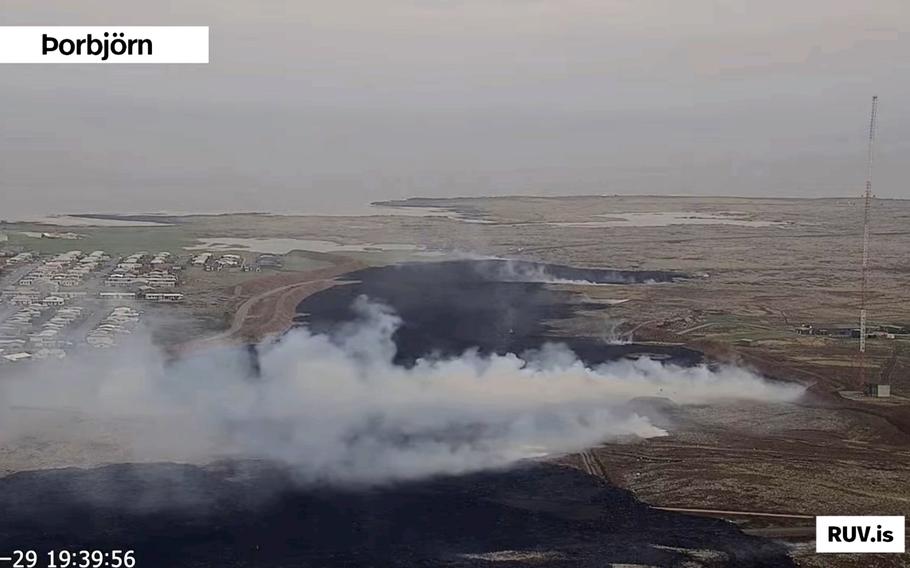
A screenshot of live footage from Iceland’s national broadcaster RÚV on May 29, 2024, shows smoke billowing from the ground near a communications mast used by the U.S. Navy, at right. (RÚV)
Lava from the latest volcanic eruption in Iceland has reached a defensive barrier around a U.S. Navy communications site on the southern coast, according to the country’s national broadcaster.
Live footage by RÚV on Thursday afternoon showed smoke coming from the ground near one of two masts at the Naval Computer and Telecommunications Station in Grindavik.
“The expectation, at this point, is that the defenses will hold,” Darren Adam, a presenter and reporter with RÚV’s English service, said, referring to walls of crushed rock that Icelandic authorities started building last year ahead of a series of volcanic eruptions.
Staffers at the telecommunications facility, who include one U.S. Navy civilian and Icelandic supporting personnel, were evacuated months ago because of the threat posed by the volcanic activity, the Navy said in February.
Normally, the facility operates 24/7 and plays an important role in radio communications with various Navy and NATO vessels in the Atlantic Ocean by helping ensure their safety, U.S. Naval Forces Europe-Africa spokesman Lt. Cody Keim said at the time.
Keim refused to say whether the two communication masts could function without staff on the ground, citing operational security.
On Thursday, activity near the site appeared to be less than it was when the eruption began the previous afternoon.
Much larger plumes of smoke were initially visible and at times nearly hid one of the masts. Around midnight local time, several prolonged flareups of lava could be seen in the footage.
In an update Thursday, Iceland’s Met Office confirmed that the power of the eruption had decreased significantly, although lava was still bursting at Hagafell and Sylingarfell nearby.
The town of Grindavik is about 30 miles south of the capital, Reykjavik, and about 15 miles from Keflavik International Airport, where U.S. forces operate. There were no initial reports of disruption at the airport because of the volcano.
The eruption is the fifth on the Reykjanes Peninsula, in southwestern Iceland, since December. Until March 2021, the peninsula had not experienced an eruption for 800 years, but scientists believe the area is entering a new volcanic era that could last for decades or even centuries.
Brad Martin, a retired Navy captain and researcher at Rand Corp., said that if the facility were disabled or destroyed by volcanic activity, the military would have backup options.
“There are always alternative pathways, usually there are multiple satellite systems that can do the same thing,” Martin said.
Iceland, a founding member of NATO, has a coast guard but no military of its own.
At Iceland’s invitation and amid concerns of Russian aggression in Europe, the U.S. military in recent years has boosted activity at Keflavik, including deployment of a rotational detachment of P-8 Poseidon aircraft to the base for tracking submarine movements.
In 2020, the Pentagon awarded $38 million in contracts for airfield improvements to allow for expanded missions.